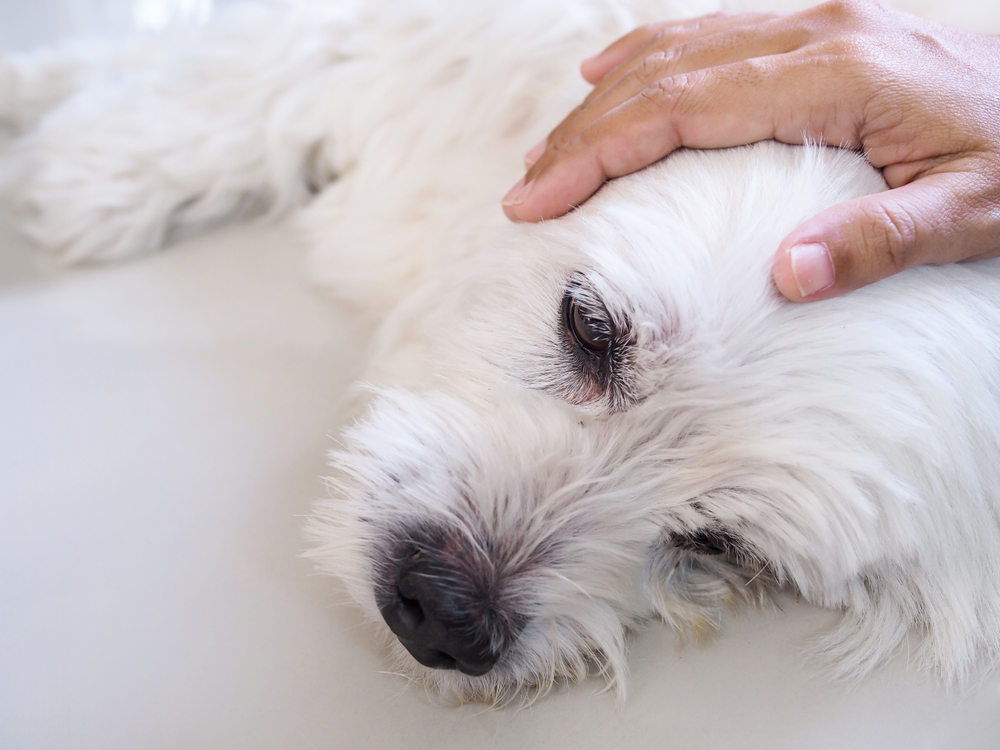Click to Skip Ahead
Epilepsy is a condition that causes seizures in dogs, but not all dogs that have a seizure will have epilepsy. Seizures present in various ways, and they are a sign of illness rather than a disease in themselves. Of course, if you have seen a vet for your dog’s seizures recently, epilepsy may have been mentioned. Read on to learn more about epilepsy.
What Is Epilepsy?

Epilepsy refers to a seizure disorder, but the language around epilepsy can be confusing at times. In humans, “epilepsy” is a recurrent seizure disorder caused by any condition in the brain.
In veterinary medicine, “epilepsy” is commonly used to describe the condition of idiopathic epilepsy, which is a seizure disorder without any physical problems in the brain, toxin exposure, or metabolic abnormalities. Idiopathic means an unknown cause, but while we do not always know the exact mechanism of the seizures, there seems to be some genetic basis.
A seizure is caused by uncontrolled electrical activity in the brain.
- Generalized seizure: Seizure activity is in the entire brain. This is the most recognizable seizure, which includes loss of consciousness and body spasms.
- Partial seizure: Seizure activity in just one area of the brain, leading to uncontrolled movements in one body part. There is no loss of consciousness.
- Complex partial seizures: It’s a type of partial seizure that leads to a complex response that looks like abnormal behavior, aggression, or hallucinations.
- Absence seizures: This is rare in dogs but involves unresponsiveness and blank staring, with or without muscle movements.
- Cluster seizures: 2 or more seizures within 24 hours.
- Acute repetitive seizures: 2 or more seizures within 5–12 hours
- Status epilepticus: Continuous seizure for 5 or more minutes, or two or more seizures with no recovery between seizures
What Are the Signs of Epilepsy?
Your dog may have epilepsy if they have had more than one seizure. Dogs with epilepsy tend to have generalized seizures, while other seizure disorders can lead to partial seizures.
- Anxiety or abnormal behavior before the episode
- Collapse
- Uncontrolled limb movements
- Violent shaking
- Frothing at mouth
- Loss of consciousness
- Stumbling
- Vocalizing
- Uncontrolled urination or defecation
- Stiff body
- Extended limbs
- Standing and staring, non-responsive
- Fly biting
- Jaw chattering
- Twitching of one body part
Seizures can sometimes be hard to identify and misinterpreted as behavioral, movement, or sleep disorders. Also, sometimes a dog collapses for reasons other than a seizure. For example, fainting occurs in patients with heart problems when there is not enough oxygen delivered to the brain.
Disorientation after an episode seizure (known as the post-ictal phase) can last minutes to hours and is a sure sign that the episode was a seizure. Dogs with syncope return to normal very quickly.
If your dog is showing any of these signs and seeking the best possible treatment for your pup, we recommend speaking with a vet.
PangoVet. It’s an online service where you can <b>talk to a vet online</b> and get the personalized advice you need for your pet — all at an affordable price!
</p>
<div class="su-button-center"><a href=https://www.dogster.com/ask-the-vet/"https://pangovet.com/?utm_source=dogster&utm_medium=article&utm_campaign=dog_preventative_wellness%22 class="su-button su-button-style-default" style="color:#FFFFFF;background-color:#FF6600;border-color:#cc5200;border-radius:9px;-moz-border-radius:9px;-webkit-border-radius:9px" target="_blank" rel="nofollow"><span style="color:#FFFFFF;padding:0px 24px;font-size:18px;line-height:36px;border-color:#ff944d;border-radius:9px;-moz-border-radius:9px;-webkit-border-radius:9px;text-shadow:none;-moz-text-shadow:none;-webkit-text-shadow:none"> Click to Speak With a Vet</span></a></div></div></div>"}" data-sheets-userformat="{"2":4224,"10":2,"15":"Arial"}" data-sheets-validation-definition="{"1":{"1":{"1":23,"2":[{"1":1,"3":{"1":{"1":[{"1":4,"6":1},{"1":1,"2":"="}]},"2":{"1":[{"1":2,"2":"="},{"1":3,"3":1}]},"3":"R1]S"},"4":[{"1":{"1":1,"2":21,"3":0,"4":1,"5":2236944,"6":"841046713"},"2":1}]}],"6":[{"1":{"2":{"1":2,"2":"❤️ Preventative wellness"}},"2":{"1":2,"2":676776},"3":{"1":2,"2":12574966}},{"1":{"2":{"1":2,"2":"⚠️ Urinary problems"}},"2":{"1":2,"2":676776},"3":{"1":2,"2":12574966}},{"1":{"2":{"1":2,"2":"🩺 Other"}},"2":{"1":2,"2":676776},"3":{"1":2,"2":12574966}},{"1":{"2":{"1":2,"2":"👁️ Eye issues"}},"2":{"1":2,"2":676776},"3":{"1":2,"2":12574966}},{"1":{"2":{"1":2,"2":"🐕 Behavior & training"}},"2":{"1":2,"2":676776},"3":{"1":2,"2":12574966}},{"1":{"2":{"1":2,"2":"🤮 Vomiting"}},"2":{"1":2,"2":676776},"3":{"1":2,"2":12574966}},{"1":{"2":{"1":2,"2":"🛡️ Flea & tick"}},"2":{"1":2,"2":676776},"3":{"1":2,"2":12574966}},{"1":{"2":{"1":2,"2":"🍎 Ate or drank"}},"2":{"1":2,"2":676776},"3":{"1":2,"2":12574966}}]},"2":{"1":{"1":[{"1":4,"6":0},{"1":4,"6":1},{"1":2,"3":"CONDITION_ONE_OF_RANGE","4":2},{"1":1,"2":"="}]},"3":"R0]R1]FCONDITION_ONE_OF_RANGE:2]S"},"3":[{"1":{"1":0,"2":1,"3":0,"4":1,"5":1118464},"2":0},{"1":{"1":1,"2":21,"3":0,"4":1,"5":2236944,"6":"841046713"},"2":1}]},"2":"","3":1,"4":1,"6":0}" data-sheets-validation-id="0"> If you need to speak with a vet but can’t get to one, head over to PangoVet. It’s an online service where you can talk to a vet online and get the personalized advice you need for your pet — all at an affordable price!

What Are the Causes of Epilepsy?
As previously mentioned, the cause of epilepsy is suspected to be genetic.
- Beagles
- Belgian Tervurens
- Bernese Mountain Dogs
- Border Collies
- Boxers
- Cocker Spaniels
- Collies
- Dachshunds
- German Shepherds
- Golden Retrievers
- Irish Setters
- Irish Wolfhounds
- Keeshonds
- Labradors
- Miniature Schnauzers
- Poodles
- St. Bernards
- Shetland Sheepdogs
- Huskies
- English Springer Spaniels
- Pembroke Welsh Corgis
- Wire-Haired Fox Terriers
However, just because a dog has had a seizure does not mean they necessarily have epilepsy. Epilepsy can only be diagnosed once other causes of seizures have been ruled out.
Causes Outside the Brain
Extracranial causes of seizures originate outside of the brain. As the brain is healthy to begin with, they are sometimes called reactive seizures.
- Low blood sugar
- Low blood calcium, which commonly occurs in lactating dogs
- Liver disease
- Liver shunts
- Kidney disease
- Medications like Metronidazole and rarely Isoxazoline flea and tick products
- Toxins like metaldehyde, caffeine, and theobromine (found in chocolate)
Causes Inside the Brain
Intracranial causes of seizures originate within the brain.
- Brain tumors like meningiomas
- Previous trauma, which causes scarring of the brain
- Infectious diseases like Rabies, Distemper, Toxoplasma, and Neospora
- Inflammatory diseases like meningoencephalitis of unknown origin (MUO)
- Cerebrovascular accident (stroke)
Your dog’s age may provide clues into the causes of their seizures. Epilepsy usually starts between 6 months and 6 years. Puppies are more likely than adults to have a congenital defect, intoxication, or an infectious disease. Dogs older than 6 are more likely to have an underlying disease like organ disease, intracranial tumors, or a stroke.
Dogs with structural brain disease are likely to have behavioral changes like aggression, loss of house training, irritability, lethargy, head pressing, not greeting owners, restlessness overnight, and sleeping more.

How to Care for a Dog With Epilepsy
Seizure disorders like epilepsy require veterinary intervention, so the first step is a vet visit. However, once your dog has been diagnosed and treated according to your vet’s recommendations, there are a few things you can do to help.
- Keep a seizure diary: Since seizures usually occur only sporadically, they can be hard to track. If you visit the vet only a couple of times a year, it can be hard to give accurate accounts of your dog’s seizures. We recommend keeping a diary that includes the date and duration of any seizures and other relevant information like potential triggers or what the recovery was like.
- Reduce hazards: Since you never know when your dog is going to have a seizure, you should take precautions to keep them safe. We recommend never allowing your dog to swim since seizure dogs can drown even in shallow water. Even if you are right there, the chances are that your dog will inhale water before you can help them. Block off any dangerous areas of the house, like fireplaces, pools, and stairs, in case your dog has seizures.
- Avoid triggers: Some dogs have triggers for seizures, like light, sound, and movement. Stress is the most commonly reported trigger, so if your dog has certain phobias, try to avoid them. Dogs with epilepsy often have behavioral problems, and behavioral treatments can be helpful, so talk to your vet about any behavior concerns.
- Follow your vet’s instructions: Administer any medication according to the vet’s instructions. Never stop medication simply because it is working and your dog hasn’t had any seizures for a while. Stopping and restarting medication can worsen seizures, as can irregular dosing schedules. Your dog will likely need follow-up checks, too.
- Know what to do when your dog has seizures: If your dog loses consciousness during a seizure, you must act to keep them and yourself safe. Remove anything from the vicinity that could be a hazard. Remember, dogs can accidentally bite during a seizure, so stay away from their heads. They are unconscious, and there is no need to comfort them.
- Know when to seek help: If your dog is in status epilepticus (a seizure lasting more than 5 minutes or back-to-back seizures), it is an emergency. Your pet could die because of their high body temperature. If your dog has more than three seizures in 24 hours, they should also be seen urgently for further seizure control. Other than that, whether you need to see a vet depends on your pet’s condition, so ask your vet what to do if your pet seizures again.
- Spay or neuter your dog: One study showed that unspayed females are the most likely to experience frequent cluster seizures. Neutered dogs were also less likely than intact males to experience cluster seizures.

What to Expect at the Vet
Your vet will talk to you about your pet’s episode and ask questions to determine if it is likely to be a seizure. They will take into account your pet’s age, breed, and lifestyle and examine your dog to narrow down what could have caused the seizure.
Your vet will likely perform basic tests, such as blood tests, to look for extracranial causes of seizures. Depending on your situation, your vet may recommend a referral to a specialist center, where they can perform advanced diagnostics, like spinal fluid sampling, and advanced imaging, like MRI.
Epilepsy is diagnosed by ruling everything else out or considered likely in your pet. In that case, anticonvulsant medication is an option but is not usually started after a single first seizure. Your pet may not have a seizure for years or ever again, so we don’t want to start medication if it is not necessary.
On the other hand, medication may be necessary depending on the frequency and severity of the seizures. This medication is generally lifelong. Common anticonvulsant medications include phenobarbital, levetiracetam, potassium bromide, and zonisamide.
One study showed that treatment with anticonvulsants improved the quality of life in dogs; however, a high proportion of dogs still had regular seizures on a single medication.
Frequently Asked Questions (FAQ)
Are There Any Alternative Therapies Available?
Some holistic therapies can be used to treat epilepsy alongside the medication prescribed by your vet. A diet high in medium-chain triglycerides, like Purina Pro Plan NeuroCare, can reduce seizure activity. Specially trained veterinarians can incorporate Traditional Chinese Veterinary Medicine into your dog’s treatment plan, including acupuncture and herbal remedies. Some essential oils are shown to trigger seizures in healthy and epileptic people, so we recommend avoiding essential oils unless your vet recommends otherwise. Ocular compression is thought to stimulate the vagus nerve and may be effective in aborting seizures.
How Long Can Dogs Live With Epilepsy?
Dogs with epilepsy can live normal lives, and most do well on medication. However, if the seizures are poorly controlled, they may have a poor quality of life and even shorter lives. For other seizure disorders, the prognosis depends on the underlying disease.

Conclusion
Epilepsy can be life-threatening, but with the proper treatment, your dog can go on to live a normal and healthy life. Without advanced diagnostics, you cannot be 100% sure that your dog truly has epilepsy, but it is often treated on a presumptive basis if your dog’s age and signs fit.
Treatment typically consists of medication and keeping your dog safe when they have a seizure. It is essential to follow all your vet’s instructions carefully and know when your dog needs to see a vet. There is no cure for epilepsy, and the treatment will continue for the rest of their life.
Featured Image Credit: Dmytro Zinkevych, Shutterstock













